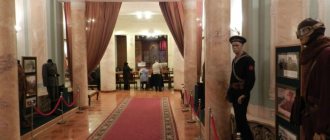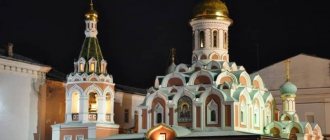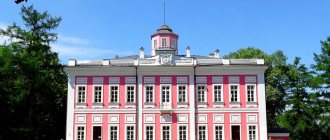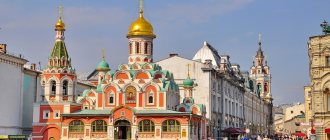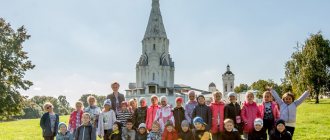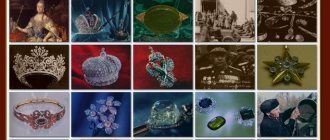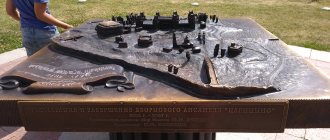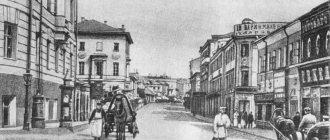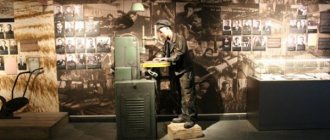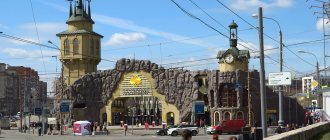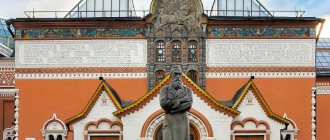Audio tours of St. Petersburg | Excursions around St. Petersburg here and here | Discount for booking accommodation | Car rental in St. Petersburg | Excursion tours to St. Petersburg
The second main art museum of St. Petersburg is the Russian Museum. There are no such crowds of tourists as in the Hermitage, but you still need to know the nuances in order to get the most from this kingdom of Russian art. In this article we will look into when to go to the museum, its opening hours and how to buy tickets.
Where can you buy tours now?
Russian Museum: exhibitions
The buildings of the complex house permanent exhibitions and temporary exhibitions.
The Mikhailovsky Palace presents collections of ancient Russian painting of the 12th-17th centuries, Russian art of the 18th-19th centuries, as well as works of folk art, arranged in chronological order. Old Russian icons occupy a special place.
Museum exhibits, © Russian Museum
In the Benois building you can get acquainted with the decorative and applied arts of the last century. It displays porcelain and glass items, textiles and furniture, works by the founders of Russian avant-garde art and an exhibition dedicated to the development of new trends in art that emerged at the turn of the 19th and 20th centuries.
The Stroganov Palace houses the Mineralogical Cabinet with a rich book collection and a collection of minerals. In addition, the palace has a permanent exhibition “Russian Empire style”.
The Mikhailovsky Castle houses an open collection of sculpture with works by masters of the 19th and 20th centuries, the best works of avant-garde artists of the 20s of the last century and works of modern experimenters. Separate rooms house a portrait gallery and paintings characterizing St. Petersburg society during the Romanov era. The pavilions of the Mikhailovsky Castle are intended for temporary exhibitions.
The Marble Palace represents a unique collection of the Rzhevsky brothers, who in 1998 transferred to the Russian Museum a rich private collection that had been formed over about 50 years. It includes works of graphics, painting, and sculpture. In addition, the Marble Palace houses the Ludwig Museum, the exhibits of which were donated to the complex by German collectors. Here you can see works of the second half of the 20th - early 21st centuries. Visitors to the Marble Palace can get acquainted with the office and music room of the last owner of the building, one of the founders of the Pushkin House - Grand Duke Konstantin Romanov.
Hall of the Marble Palace, © Frank Ciliberto
The Summer Palace of Peter I has preserved the interiors in which the emperor periodically lived. In the House of Peter I, objects are exhibited that are in one way or another connected with the Peter I era. The walls are covered with canvas, “moon” glass is inserted into the windows, and in one of the rooms there is an emperor’s chair.
Exhibitions 2021 at the Russian Museum
Russian Museum: opening hours 2021
The objects of the museum complex are open to the public every day except Tuesday:
- Mon. - from 10:00 to 18:00 (Mikhailovsky Palace and Benois building - until 20:00);
- Wed., Fri.-Sun. — from 10:00 to 18:00;
- Thurs. — from 13:00 to 21:00.
Closed on December 31st and January 1st.
Interior of the Mikhailovsky Palace, © Russian Museum
The Mikhailovsky and Summer Gardens can be visited all year round, with the exception of April. Operating mode:
- from 01.05 to 30.09 - from 10:00 to 22:00;
- from 01.10 to 31.03 - from 10:00 to 20:00.
The summer garden is closed on Tuesdays.
Opening hours of the Russian Museum and visiting rules
How to get there by metro
Nearest metro stations: Gostiny Dvor and Nevsky Prospekt.
To get to the main building of the museum from the Nevsky Prospekt metro station, you need to walk along Mikhailovskaya Street to the square with the monument to A.S. Pushkin, behind which the Palace is located.
In addition to the metro, you can get to the museum by your own car or taxi, as well as by other types of public transport (bus, trolleybus, tram).
Ticket prices
The cost of entry to the Russian Museum depends on the object of visit and the citizenship of the tourist:
- for adults - from 500 rub.
- for students and pensioners - from 250 rubles.
It is possible to purchase complex tickets and subscriptions.
Tickets and excursions to the Russian Museum Buy at
Unique collections, © Julia
Certain categories of citizens, including children under 16 years of age, have the right to free admission to the museum. As an experiment, on the 18th of every month, young people under the age of 18 receive free access.
Cost of tickets and services
Hermitage
The Hermitage consists of five divisions:
- Main museum complex (Winter Palace, Small Hermitage, Large (Old) Hermitage, New Hermitage);
- Menshikov Palace;
- Eastern wing of the General Staff building;
- Winter Palace of Peter I;
- Museum of Imperial Porcelain.
Opening hours of the Hermitage museums:
- Tuesday, Thursday, Saturday, Sunday – 10.30 – 18.00,
- Wednesday, Friday: 10.30 – 21.00.
- Day off is Monday.
Ticket price to the Hermitage:
- 300 rub. – entrance to one of the separate objects: General Staff, Winter Palace of Peter I, Menshikov Palace, Museum of Imperial Porcelain
- 400 rub. gives the right to visit the Main Museum Complex, the General Headquarters, the Winter Palace of Peter I;
- 700 rub. – with this ticket you can visit: The main museum complex (Palace Square, 2).
- Main headquarters (Dvortsovaya Square, 6/8).
- Winter Palace of Peter I (Dvortsovaya embankment, 32).
- Menshikov Palace (University Embankment, 32).
- Museum of the Imperial Porcelain Factory (Obukhovskaya Oborona Ave., 151).
The ticket is valid for one day. Free for children, students, pensioners and other beneficiaries (see the Hermitage website). Free for everyone - the third Thursday of each month and December 7.
Hermitage Treasure Gallery (gold and diamond storerooms).
Working hours:
- Tuesday – Saturday – 11.00 – 16.00;
- Sunday – 11.00 – 15.00;
Visit only with excursion groups.
Ticket price: 350 rub. – excursion tour to one of the storerooms. Tickets are sold at the museum box office on the day of the visit.
The schedule of excursions is available at information stands and at the administrator. Tel. for inquiries (812) 712-90-79
Restoration and storage (Zausadebnaya, 37)
Opening hours Wednesday - Sunday, sessions 11.00, 13.00, 13.30, 15.30.
- Visit only with a guided tour by reservation.
- The cost of visiting is 550 rubles.
- Beneficiaries only pay for the excursion - 250 rubles.
- Tel..
The museum and restoration and storage center are closed on January 1 and May 9.
A little secret: How to get to the Hermitage without queuing: in the General Staff building, buy a ticket for 400 rubles. Using it you can visit the Winter Palace without queuing.
Museum website: hermitagemuseum.org; tel. 710-90-79, 710-96-25.
You can find hotels near the Hermitage here, and hostels here.
Buildings of the Russian Museum
The museum complex includes four palaces, a castle with pavilions, one building and a house.
Mikhailovsky Palace
The author of the project of the former grand ducal palace, named after the youngest son of Paul I, Mikhail Pavlovich, is Carlo Rossi. Construction of the building took place in the period 1819–25. It was sold in 1895 to the state treasury by the grandchildren of the Grand Duke. It was the Mikhailovsky Palace that served as the basis for the creation of the “Russian Museum of Emperor Alexander III”. The area of the palace is more than 24 thousand square meters. m.
Address - st. Inzhenernaya, 4
Hall of the Mikhailovsky Palace, © Yulia
Benoit Corps
The building bears the name of one of the authors of the project - architect L. Benoit. The building was built in two stages - before and after the October Revolution. The Rossi wing, which connected the Mikhailovsky Palace with the Benois Wing, appeared in the post-war years.
Address - st. Inzhenernaya, 4
Stroganov Palace
Construction of the palace complex began in the 1720s. By the middle of the 18th century, individual buildings were united according to the design of F. Rastrelli. The Stroganov dynasty owned the palace until 1918.
Read more in our article.
Address - Nevsky pr., 17
Palace interiors, © Russian Museum
Marble Palace
The unique architectural monument was built by order of Catherine II. 1768–85 for Count G. Orlov. After the death of the owner, the empress bought the palace for her grandson, Konstantin Pavlovich. Subsequently, it was inherited by representatives of the imperial family, until, due to lack of funds for maintenance, the complex was forced to be sold. At the beginning of 1917, it became national property.
Address - st. Millionnaya, 5/1
Summer Palace of Peter I
The building was built in 1712 by the architect D. Trezzini. Foreign craftsmen were involved in the design of interiors and facades. The palace has been preserved almost unchanged. After the death of the emperor, court servants and influential dignitaries lived within its walls. After Peter I, the residence was never used for its intended purpose. The building has been part of the Russian Museum since 2004.
Address - Summer Garden, letter A
Summer Palace of Peter I, © Dr. Michael Brandt
Mikhailovsky Castle
The imperial residence was erected by order of Paul I on the site of Elizabeth Petrovna's Summer Palace, which was dismantled after the death of Catherine II. The castle is one of the largest architectural monuments of St. Petersburg and is a striking example of 18th-century architecture. Several eminent architects of that time were involved in the development of the project. Work on it lasted about 12 years. Construction period - 1797-1800.
Read more about Mikhailovsky Castle.
Address - st. Sadovaya, 2
East and West pavilions
Initially, they were intended to house ladies-in-waiting and state ladies of the imperial court. The buildings were built in 1800, and 19 years later they were transferred to the management of the Engineering Department. The pavilions became part of the Russian Museum in 2001.
Addresses - st. Inzhenernaya, 8 and 10.
Pavilion of St. Michael's Castle, © Sarvesh Ranjan
House of Peter I
The wooden frame was erected in 1703. Despite the fact that the unique architectural and historical monument has compact dimensions (only 12.7 by 5.7 m), it is the most important object preserved from the times of Peter the Great.
Read more about the House of Peter I.
Museum halls
Each object of the architectural and artistic complex is unique in its own way. It will take more than one day to get acquainted with it. Online walks through its halls will help you prepare for a fruitful visit to the grandiose museum.
Virtual tour on the official website
Museum paintings, © Julia
Savior on Spilled Blood
Opening hours of Savior on Spilled Blood: 10.30 – 18.00. Evening programs 18.00 – 22.30 (from 1.05 to 30.09). Day off – Wednesday.
Museum ticket price:
- Total cost 350 rub.
- International ISIC card holders – 200 rubles.
- Youth (7-18), students, pensioners – 100 rubles.
- Ticket price in the evening is 400 rubles.
Gardens
The palace and park complex of the Russian Museum includes two gardens - Summer and Mikhailovsky. Their total area, including the palace courtyards, is about 30 hectares. The park areas were finally formalized in the 21st century.
Every year, a large-scale festival “Imperial Gardens of Russia” is held on the territory of the palace and park complex.
The summer garden was laid out in 1704 by order of Peter I. Russian, Italian and Dutch landscape architects worked on its project. The Emperor personally drew the initial plan for the garden, more than once made corrections to the design of the Dutchman J. Roosen, and passionately oversaw the development of the park area. The last comprehensive reconstruction was carried out in 2009–11, and in 2012 the Summer Garden opened to visitors. There are several objects located on its territory.
More details in our article.
Summer Garden, © Vyacheslav Vertyanov
Mikhailovsky Garden is one of the unique parks, within the boundaries of which different landscape styles are organically combined. It was created by order of Peter I by the architect Leiblon at the beginning of the 18th century, and at the beginning of the 19th century it was redesigned according to Rossi’s design. After the October Revolution, the park was transferred to the public domain. Stage podiums, entertainment pavilions, children's and sports grounds were built here. Large-scale reconstruction was carried out in 2001–07.
About the Mikhailovsky Garden - on our website.
Car sharing
A new service for Russia, but quickly gaining popularity, is car sharing. This is a short-term (otherwise it will be very expensive) car rental on a per-minute basis. Cars that can be rented have a characteristic black and orange color with a corresponding inscription on the sides. A person who needs a car finds it through a mobile application (but must first register in the system).
There are several companies providing car sharing services in St. Petersburg. One of the most popular (and cheapest) is Yandex.Drive, a minute of rent costs 5 rubles.
Story
The idea of creating the Russian Museum belongs to Emperor Alexander III, and the implementation of the project belongs to Nicholas II. The decree establishing the institution was signed in 1895, and its grand opening took place in 1898. By this time, it had come from the Academy of Arts, the Hermitage, suburban palaces and private collections.
Subsequently, the exhibitions were replenished with allocated funds and donations. After the October Revolution, the Russian Museum received a huge number of nationalized works of art. During the Second World War, the most valuable exhibits were evacuated, the rest were mothballed and hidden in basements.
Today the museum structure is represented by several departments, including scientific, restoration, information, methodological, etc.
